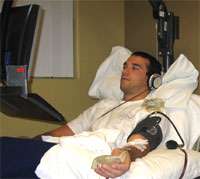Donate Platelets
Platelet (Apheresis) Donations
Do something Extraordinary today - make a platelet donation

Platelet donors make a special kind of donation to give select components of their blood: Platelets, red blood cells, and plasma. Platelet donations are an essential part of treatment for patients with cancer and other life-threatening medical conditions. By becoming a platelet donor, you save the life of a critically ill patient with special transfusion needs.
Platelets
Platelets is the part of the blood that aids in clotting and is important for emergencies. It helps patients with cancer, leukemia, transplants and blood disorders. In a process called apheresis, whole blood is drawn, selected component parts are separated out, and the rest of the blood is safely returned to the donor. Since platelet donation visits can take up to three hours, donors sit in ergonomically designed contoured chairs, and have the opportunity to enjoy streaming television options. Learn more about .
What is apheresis?
Apheresis is the process of separating blood into its different components: Platelets, red blood cells (RBCs) and plasma. During a platelet donation, we collect these special components and return the rest of the blood to the donor.
Why are platelets important?
Platelets are essential for blood clotting. Platelet transfusions help to support patients with bleeding disorders and those undergoing:
- Cancer therapy
- Open-heart surgery
- Organ transplantation

Platelets have a very short shelf-life and must be transfused within five days of collection. This requires constant replenishment of the hospital supply. Your frequent and consistent platelet donations are much needed. You can donate platelets as frequently as once a week, up to 24 times a year!
Plasma
Plasma is the liquid portion of the blood containing critical clotting factors. Plasma is used to treat patients with coagulation factor deficiencies, such as patients with liver failure, and those patients with certain bleeding disorders. Plasma donations can be made every four weeks. Type AB donors are in high demand because they are “universal” plasma donors. Their plasma can be used to treat all patients.
Why do a platelet donation instead of a whole blood donation?
- Platelet donors can help more patients by donating more units during each donation.
- Apheresis collections are optimized based on donor/patient blood types, the donor's ability and desire to donate, and the patients' transfusion needs.
- Only the blood components needed are collected for our patients; the other components are returned to the donor.
- Platelet donors can donate weekly, up to 24 times a year.
Making a platelet donation is safe and easy
Donor safety is our top priority — automated blood collections are very safe. During the donation, blood is drawn from one arm using a sterile needle and channeled through single-use tubing into a single-use sterile collection kit within the apheresis machine. The machine spins the blood to separate it, collects the most needed components, and safely returns the remaining blood through the same sterile needle used for collection.
To ensure that only a safe amount of blood is taken, the collection process is customized based on the donor's physical size and donation frequency, as well as multiple other factors.
We also ensure each donor is comfortable and enjoys their donation experience. All donors get to relax in a comfortable chair while giving life-saving blood components for others.
How will my blood and platelet donation help UCLA patients?

You may not ever meet the patient who receives your platelet donation, but they are real. Below are a few examples of the types of patients who need blood from donors like you:
A cancer patient can require up to 2 units of platelets per week.
An automobile accident victim can use up to:
- 50 units of red blood cells
- Two units of platelets
- 10 units of plasma
A liver transplant recipient uses on average:
- 25 units of red blood cells
- Five units of platelets
- 40 units of plasma
A stem cell transplant recipient can use up to:
- 10 units of red blood cells
- 10 units of platelets with ongoing outpatient transfusion needs
A heart surgery patient uses on average:
- Seven units of red blood cells
- Two units of platelets
- Four units of plasma
Become a repeat donor
Platelet donations can be made once a week, up to 24 times per year and blood donations can be made once every 56 days, up to six times per year.
Who can make a platelet donation?
All platelet donors must meet certain eligibility criteria. Find out if you qualify
Ready to donate?
Your selfless donation can change the lives of many patients for the better. Please call us at ext. 2 or schedule an appointment online today.